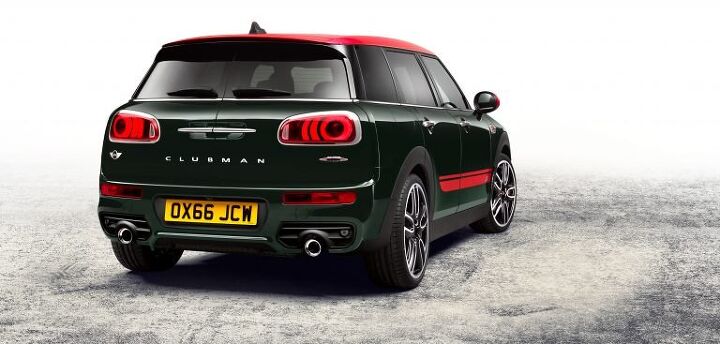2017 Mini JCW Clubman: More Power and Grip to Lure the Crossover Set

Having been a player in the small car category since its 2001 reboot, Mini now seeks to take on the burgeoning premium sporty compact segment with this, the new John Cooper Works Clubman.
With sales of the Mini brand reaching only nine-tenths of its 2013 high in the U.S. last year, will this model bait new customers into the brand’s retina-searing showrooms?
Like most siblings, the newest offspring gets some hand-me-downs but enjoys some new toys not shared with its older brothers.
The JCW Clubman squeezes 228 horsepower out of its turbocharged 2.0-liter four-cylinder, along with a relatively brawny 258 lb-ft when compared to its more mundane brethren. This power will be shuttled through a standard all-wheel-drive system provided by Mini’s in-store brand of ALL4. “Nyah-nyah”, says this Mini to its older Clubman brothers, who make do with 134 hp in Cooper trim or 189 hp in slightly more expensive Cooper S trim.
Looking closer, the JCW Clubman reveals its parent’s ability to recycle items used by its older siblings. The same two transmissions will be on offer — a standard six-speed manual and an optional eight-speed automatic — while the unique barn-doored body is adorned with the typical frippery associated with JCW editions. This means 18-inch wheels are along for the ride plus a more aggressive body kit that suggests better engine and brake cooling. The new kid is hefty like his brothers too — around 3,500 lbs. Still, with the newfound power on tap, it’s expected to complete the 0-60 mile per hour dash in about 6 seconds.
Subcompact crossover sales more than doubled in 2015, stirring up the marketplace and giving automakers an entry point with younger buyers. A survey by Strategic Vision Inc. suggests the no-kids/under-45 customer set accounts for about a quarter of the sales in this segment (compared to less than 20 percent for the industry overall). Buyers also are surfacing from the other end of the spectrum, such as Boomers who no longer need to schlep kids around in a large crossover or SUV. No doubt Mini wants a piece of that pie, too.
Think the term “subcompact crossover” and “Clubman” shouldn’t be combined in the same sentence? You’re right, of course, in terms of height: Buick’s Encore towers nearly 10-inches above the Clubman. However, this new JCW is within an inch of length and width (168.3 inches & 70.9 inches, respectively) when compared to the Encore, a model which, it must be noted, counts many of its buyers as conquests from other brands. Mini’s own Countryman is about five inches taller than the Clubman, but is half a foot shorter in length.
The new model, then, gives Mini sales staff yet another all-wheel-drive option to pitch at the rapidly increasing chorus of customers who want their traction with a dash of action.
The 2017 Mini John Cooper Works Clubman is scheduled to go on sale this December.
[Images: BMW of North America]

Matthew buys, sells, fixes, & races cars. As a human index of auto & auction knowledge, he is fond of making money and offering loud opinions.
More by Matthew Guy
Latest Car Reviews
Read moreLatest Product Reviews
Read moreRecent Comments
- 28-Cars-Later "elections"
- Tassos Good job, Senile, Corrupt Idiot-in-Chief.And when Inflation doubles again under your failed watch, LIE again that it was .. 9% when you took office, while THE REAL inflation then was less than 2%!Disgusting imbecile....
- Wjtinfwb Glad to see Toyota hanging in there with sedans. It's a bit clunky looking but no worse than a new BMW 7-series at 1/3 the price. More power would be nice but Toyota is married to the Hybrid/4-cylinder configuration. As this package gets refined I expect it will be come the norm.
- Wolfwagen The last couple of foreign vehicle manufacturers that tried breaking into the U.S. Mainstream Vehicle Market had a very hard time and 1. Couldn't get past the EPA regulation side (Mahindra) or 2. had a substandard product (Vinfast).
- Midori Mayari I live in a South American country where that is already the case; Chinese brands essentially own the EV market here, and other companies seem unable to crack it even when they offer deep enough discounts that their offerings become cheaper than the Chinese ones (as Renault found when it discounted its cheapest EV to be about 15% cheaper than the BYD Seagull/Dolphin Mini and it still sold almost nothing).What's more, the arrival of the Chinese EVs seem to have turbocharged the EV transition; we went from less than 1% monthly EV market share to about 5% in the span of a year, and it's still growing. And if — as predicted — Chinese EV makers lower their production costs to be lower than those of regular ICE cars in the next few years, they could undercut equivalent ICE car prices with EVs and take most of the car market by storm. After all, a pretty sizeable number of car owners here have a garage where they could charge, and with local fuel and electricity prices charging at home reduces fuel costs by over 80% compared with an ICE car.





































Comments
Join the conversation
I wonder if they will offer the JCW tuning kit for the regular S models... and how much will it be. They offer it for the hardtop versions.
I bet this car is totes amazeballs to drive!